First Look Review: 2023 Chevrolet Colorado packs full-size torque in a mid-size pickup
Chevrolet is coming off a rather successful year of truck sales. The Silverado (with the help of its GMC Sierra sibling) beat the Ford F-series in retail sales. Deliveries of the midsize Colorado surged 20 percent, solidifying its second-place finish behind the dated (yet ever popular) Toyota Tacoma. Chevrolet is hoping to carry that momentum into 2023 with an all-new, third-generation Colorado pickup that boasts new sheet metal, an updated wheelbase, and a fresh powertrain.
At launch, Chevrolet is offering up only crew-cab, short-bed models—the most popular (and likely most lucrative) variant. Nobody at Chevrolet will admit that there are extended cab variants in the pipeline, but we wouldn’t be surprised if those follow in a year or two. The redesigned chassis pushes the front wheel wells forward to accommodate larger tires than in previous generations, something that the Z71 and Trail Boss trims take advantage of with 31-inch and 32-inch tires, respectively.
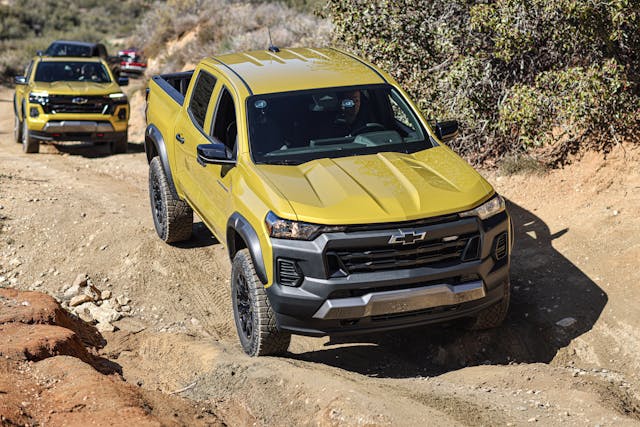
Chevrolet invited us to San Diego for a first drive of its new truck. We spent the bulk of our time behind the wheel in those mid-trim Z71 and Trail Boss models. Our route included miles on the highway, through town, on winding backroads, and a quick jaunt down some fire roads that had recently been slicked by rain.
On the first leg was in a Z71, painted Nitro Yellow Metallic. The options list included the Colorado’s Z71 Convenience Package II ($1625), bundling remote start, an eight-way power driver seat, tilt and telescoping steering wheel, wireless charging, heated seats, and an auto-dimming mirror. Also part of the II package is that a handy new “StowFlex” tailgate, featuring a lockable, water-tight storage compartment that is built in. The Z71 Convenience Package III ($1415) adds memory settings for the seat, heated steering wheel, rear seat armrests, leather upholstery, rear cross-traffic braking, blind zone steering assist, ventilated front seats, and rear park assist. The Technology Package ($950) gave our test truck adaptive cruise control, rear pedestrian alert, and HD surround vision cameras. Additional options included a power sliding sunroof ($1000), an advanced trailering package ($620), a premium audio system ($500), a spray-in bedliner ($475), and the Nitro Yellow paint ($395). All told, the window sticker indicated $49,660 out the door—not a small sum, but then again, with full-size trucks regularly cresting the $60,000 mark, that appears to be just a sign of the times. For bargain-conscious shoppers, the Work Truck starts at $30,695 including destination.
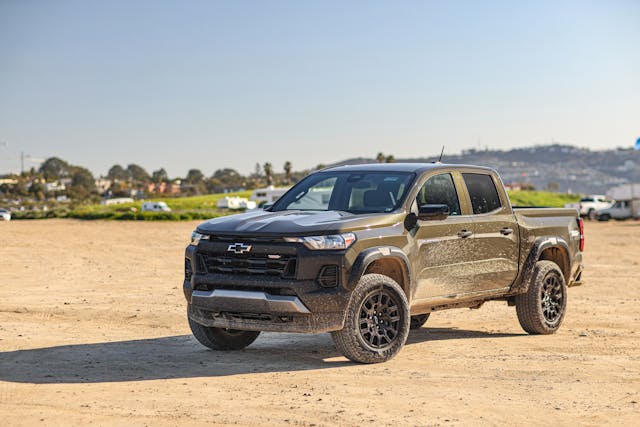
This generation of Colorado features more chiseled fenders and bedside flares—styling that’s echoed in the hood. The overall design is less fluid and more muscular-looking than the previous generation. The tweaked paneling helps Colorado better fit into the overall the Chevy truck lineup, carrying more of the machismo that permeates the light-duty and heavy-duty Silverados.
The interior of the third-gen Colorado is also new, with round HVAC vents on the far sides of the horizontal dash and an 11.3-inch touchscreen in the middle. All trim levels get the same-sized center screen, so even the Work Truck trim has a large display that uses a Google-based infotainment system that offers wireless Android Auto and Apple CarPlay connectivity. Most Colorados will ship with an 8-inch Driver Information Center (DIC) that can display engine vitals like oil temp, water temp, and transmission temp neatly around the sides of a prominent tachometer and digital speedometer. If you want an 11-inch screen ahead of the steering wheel, you’ll have to opt for a top-dog ZR2, or a GMC Canyon.
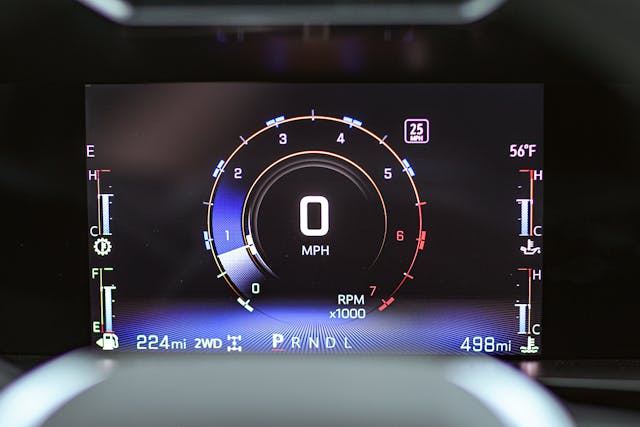
Several other optional screen settings for the DIC include a display for upcoming navigation prompts, a streamlined digital speedometer, and an off-road screen that displays pitch and roll angles, steering angle, and the status of the transfer case. These gauges are all neatly arranged and allow the driver to quickly scan vital information with ease. However, several of the customization options for this screen are selected through the touchscreen found in the center of the dash. (That’s where you’d find the trip odometer and fuel economy tracker, for example.) The interface responds quickly, but this is something that might take some getting used to, as plenty of that information was previously located in the driver information center. There are still knobs for the HVAC controls and volume, but the headlights are controlled through the screen. They get their own permanent icon, so turning on the fog lights or the automatic brights is just a tap away. Still, we can’t help but wonder what was so bad about those controls being actuated through a stalk behind the wheel or a dial just to the left of it.

Once behind the wheel, we found the Colorado a quiet, pleasant place to spend time. The center console wasn’t too intrusive and the seats offer quite a bit of fore and aft adjustment, as well as headroom, even when equipped with a sunroof. Tall drivers shouldn’t have much trouble finding a comfortable seating position without grazing the headliner. The seats were firm and comfortable, with the right mix of bolstering for corners and flat surfaces for long drives. Rear-seat passengers seem to have similar legroom as in the previous Colorado, which is to say plenty for most occupants unless the driver is particularly tall.
Specs: 2023 Chevrolet Colorado Z71
- Price (base/as-tested): $41,393 / $49,660
- Powertrain: 2.7-liter turbocharged inline-four, eight-speed automatic transmission
- Horsepower: 310 hp @ 5600 rpm
- Torque: 391 lb-ft @ 2000 rpm (optional 430 lb-ft at 3000)
- Layout: Four-wheel-drive, front-engine, five-seat midsize pickup
- Curb weight: 4250 pounds
- EPA-rated fuel economy (mpg), city/highway/combined: TBD
- Competitors: Toyota Tacoma, Ford Ranger, Nissan Frontier
Our first impression of the 2.7-liter turbo powerplant was that it sounds like a miniature semi truck, at least on the induction side. There’s a noticeable rush of spooling turbo sounds and not much exhaust noise until the throttle is really opened up. The torque from the 2.7-liter also feels like a turbodiesel, except with better throttle response. (Coincidentally, Chevy didn’t revive the 2.8-liter Duramax turbodiesel for the new Colorado because this new gas engine bested the diesel in torque and throttle response.) Around town or on the highway, adjusting speed to match traffic happens with just a nudge of the gas, allowing the turbo to spool up to provide more power. The redesigned eight-speed automatic transmission can and does stay in gear for these small demands in power and lets the engine quickly build boost. When a lot of power is demanded from aggressive throttle input, the transmission quickly kicks down one or more gears for a quick overtake or merging maneuver. All that power on tap at such low engine speed helps the Colorado achieve a 7700-pound tow rating, bringing it to the top of the mid-size class in that regard.
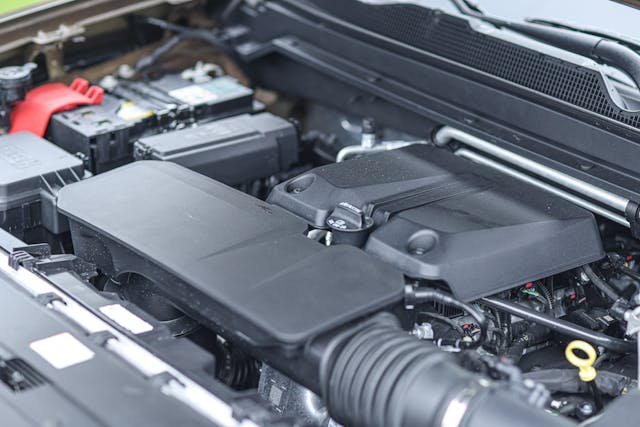
Even with the Trail Boss and Z71’s larger tires, on-road handling was sharp, and the mid-sized truck tackled curves smoothly. Off-road, both the Z71 and Trail Boss have improved ground clearance thanks to chunkier rubber and tucked-up shock mounts, making it easy to traverse ruts and rocks. We tried Hill Descent Control briefly and it helped us, along with the 360-degree cameras, to focus on picking the right line. The steering feel is properly weighted for a pickup, not overly boosted, while the brakes are assertive without being grabby. Dynamically, this feels a lot like the outgoing Colorado, which was one of the best-handling trucks in the segment. We were able to get comfortable behind the wheel immediately and focus on our biggest question about the new truck, its powertrain.
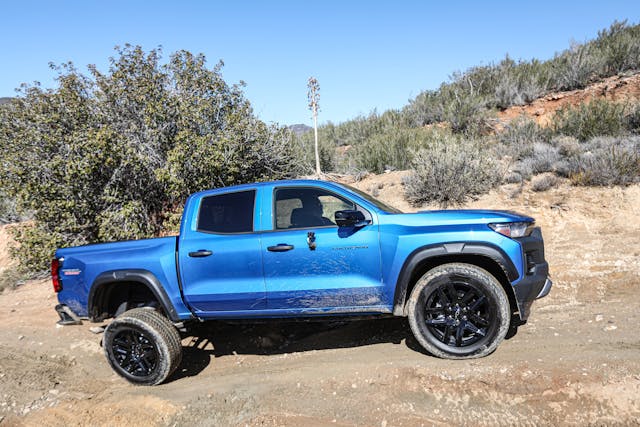
Despite sharing the same basic architecture, the Colorado actually offers two versions of the 2.7-liter four-pot, at three different output levels. The work truck trim comes with a low-boost version that produces 237 hp and 259 lb-ft of torque. It omits the piston oil squirters and a couple of noise insulators on the injector pump and injector rail to keep the price low, and it also comes with a different version of the eight-speed auto. The “Turbo Plus” engine that’s standard on LT, Trail Boss, and Z71 increases the output to 310 hp and 369 lb-ft of torque, thanks in part to those piston oil squirters that the base engine skips.
Standard on ZR2 and optional on all trim levels, the High Output version of the engine is basically the Turbo Plus setup but with a dealer-installed reflash of the computer that boosts torque to 430 lb-ft while the peak power remains unchanged. The tune makes it the most powerful gasoline engine in its class, tied with the Nissan Frontier, and it also nearly matches the torque of the Jeep Gladiator’s EcoDiesel V-6. (We took a bit of a deep dive into the 2.7-liter with Chevrolet engineer Kevin Luchansky last year, in case you’d like to learn more.)
We found that even the base work truck model feels plenty lively with “just” 237 hp, in large part thanks to its broad torque curve. The Turbo Plus is just more of the same excellent low-end and mid-range torque that makes 310 hp feel more like 350, as acceleration is linear and seemingly effortless. As much as we’d love to see and hear a 5.3-liter V-8 under the hood, we came away quite impressed with the turbo-four.
We didn’t get an opportunity to properly to check fuel economy at the pump, but the readout on the dash, which is measured in 50-mile increments by default, reported between 17.8 and 23.7 mpg, with the latter coming after a sedate 10-mile highway run pulled the average up a bit. The recorded best mileage from a previous driver was 23.9 mpg. We’d expect real-world mileage to be similar; those with a light foot on a long highway trip would be able to exceed those numbers rather easily.
Our brief time with the Colorado suggests that Chevrolet’s one-powertrain strategy will prove wise. Drivers will appreciate the ever-present torque and fuel economy of the 2.7-liter over the outgoing 3.6-liter naturally aspirated V-6. All of the adjustments to the new Colorado put Chevrolet in a great position to gain momentum in the mid-size market in 2023. With a new Ranger and Tacoma just on the horizon, the changes come not a moment too soon. We’ll have to wait and see how the ZR2 improves on what was our favorite off-road mid-sizer, but for now, the Z71 and Trail Boss have set the bar rather high.
2023 Chevrolet Colorado Z71 crew cab
Highs: Fantastic, flexible powertrain. Comfortable ride , improved off-road performance. Fuel economy seems promising.
Lows: Several features require onerous touchscreen interface. Work Truck/Trail Boss interior could use some color. Just one cab/bed configuration for now.
Takeaway: A solid contender in the mid-size market, the new Colorado has loads of capability built into every trim level.
***
Check out the Hagerty Media homepage so you don’t miss a single story, or better yet, bookmark it. To get our best stories delivered right to your inbox, subscribe to our newsletters.
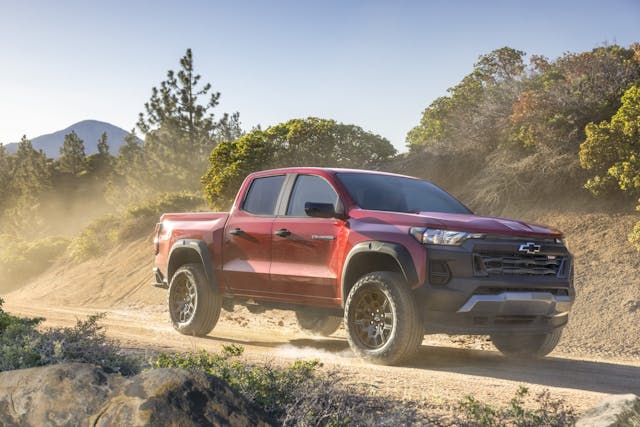
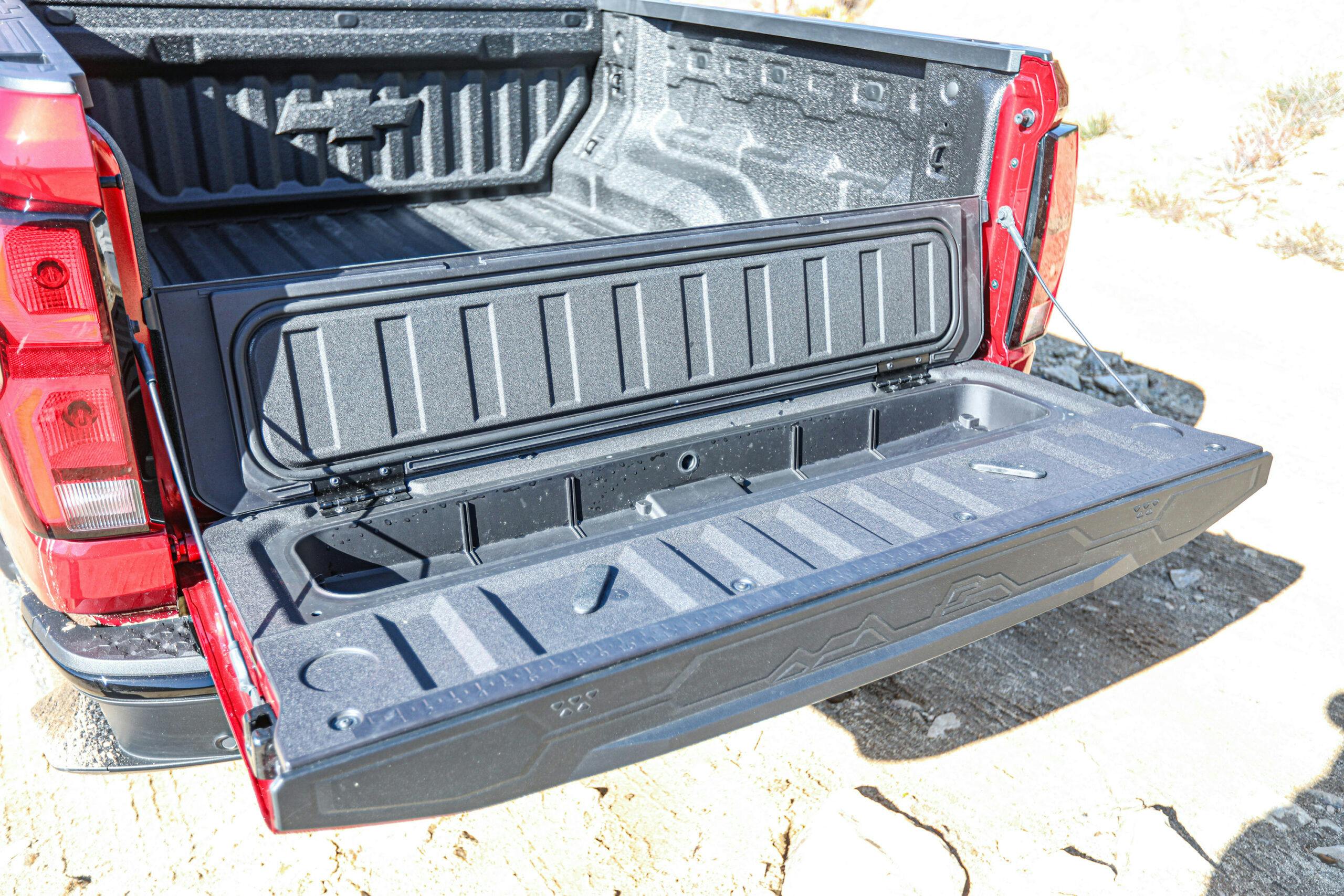
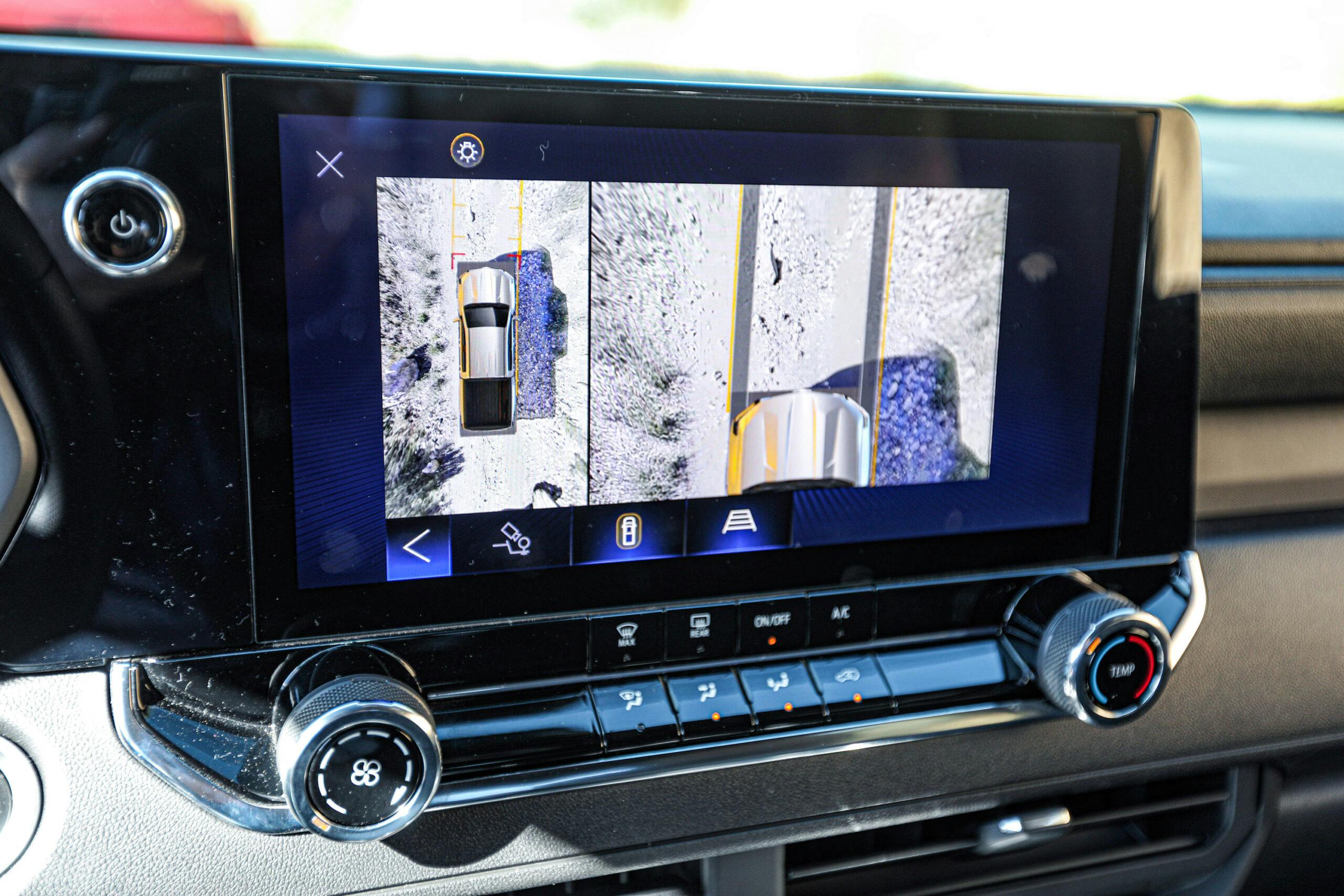
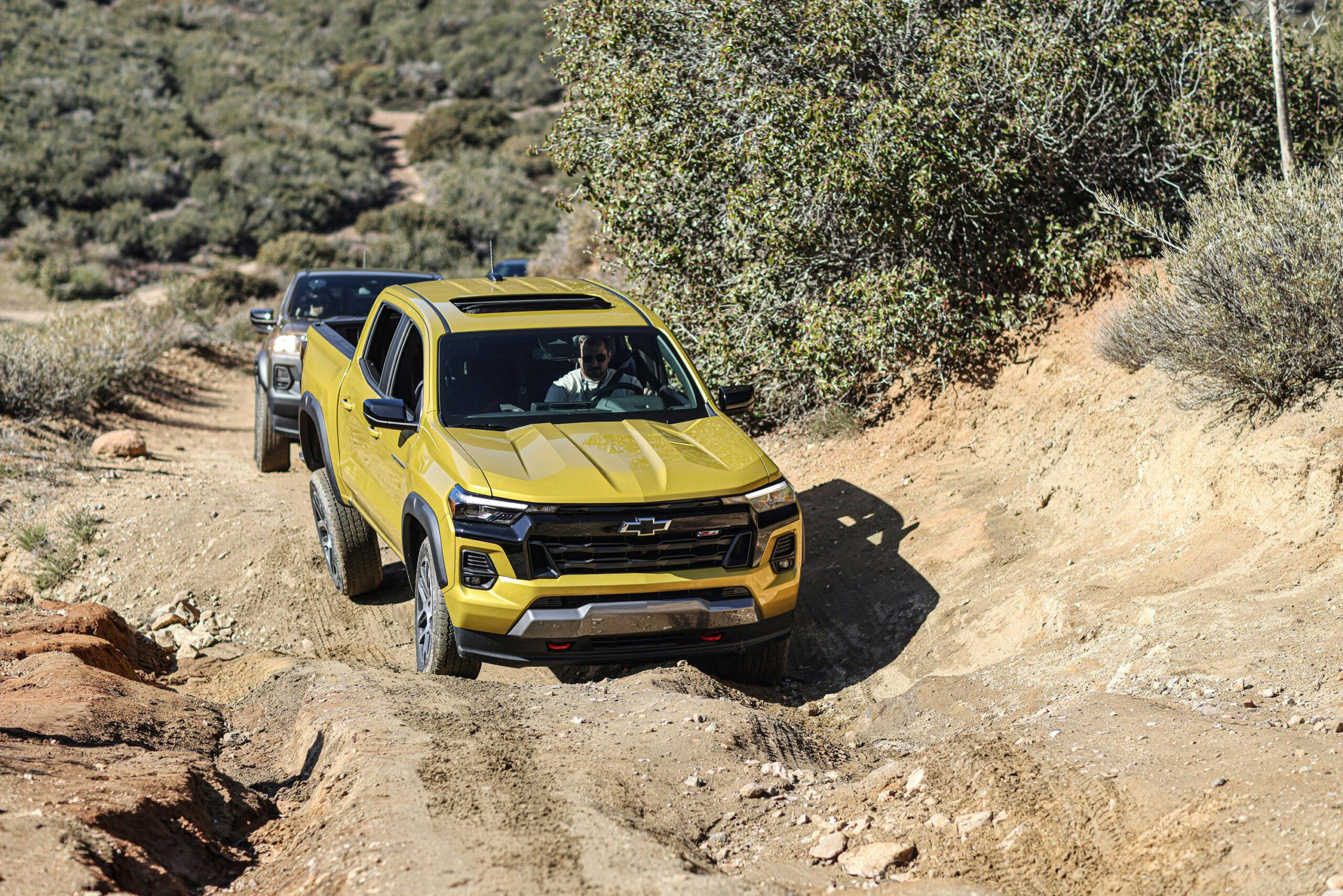


Had that engine in a rental Silvarado for a week–it averaged only 18 mpg, no better than the SBC. Would think it would have plenty of juice in the smaller truck, hope mpg is much better.
This is the triumph of prejudice over experience, and it’s late enough in the game that it will probably never go away. After a hundred years, we can’t outgrow the “swept-area” tax scheme the Europeans used to keep the little guy in little cars. It seems like it would stand to reason that a smaller engine would always get better mileage. It doesn’t work out that way, though. They just push more gas through smaller holes.
Very astute.
On a gasoline engine, especially under boost, BSFC is what it is. Small and boosted isn’t always going to save fuel.
I think I’ll pass on this and anymore new trucks. $50,000 for a puny 4 cylinder engine. Really?
Well unless GM fixes there issue with frames that rot out before the body, you won’t be able to buy a used one either.
Saw no mention of a BEV Colorado which must be planned for intro soon.
This advertisement brought to you and paid for by GM.
No, Hagerty is an insurance company.
Similar MPG to my 2011 4runner, seems like they could do better these days. But of course people want great 0-60 times so… more power!
What is the towing capacity rating?
7700 pounds in everyting but the ZR2, which is 6000.
A good start, still lots to be desired. More configurations are needed. How about a regular cab with a 6′ bed? If I wanted a passenger car I’d buy a passenger car. I’m sure crew cabs work for many people but that back seat is useless to me-I’m sure that I’m not alone in that thought. Now let’s also expand the other way. Use these components to build a mid size SUV like the original Trailblazer. None of this wimpy FWD stuff, make a RWD and 4WD truck based SUV. One more thought: No more EV’s. Way too many already.
Yes nothing but a regular cab for me. Not one company is willing to build one. So I just bought a used Tacoma I found with only 25,000 miles on it! Not one company wants my money.
Yeah, only Ford, GM and Stellantis make reg cab, 6.5′ bed pickups. So what if they’re full sized? You get more for your money.
You’re not alone but you’re part of an insignificant minority. Four door lifted sedans with no trunk lid are the de facto family car for a wide swath of families.
3% of truck sales were regular cabs in 2020. Sales have dropped so low that it doesn’t make sense to spend the money on tooling.
4 cylinder only, with not impressive mpg = no go!
It seems a bit early to suggest that the 2.7-liter fuel economy is anything less than impressive. This drive didn’t include any long stretches of highay cruising to offset the mountain roads or climbs to more than 4000 feet of elevation.
Hate to say it, but GM Design seems to miss the mark again here. They just can’t seem to get a Chevy truck styled properly any more. This thing looks like a Transformers character with all of its sharp creases and folded metal. I dislike the idea of a screen-only headlight switch as well. $50K seems stiff too.
I agree, the last few years of Chevy Trucks have been REALLY UGLY.
And, Yes….the more control knobs that they eliminate and put on the screen,
The more E’fed you are when the screen goes wonky.
While I agree, Toyota is certainly following suit. Anything in white appears to be part of the Empire.
This is a truck, right? So why no comments about truck stuff – payload, towing capacity, bed size, etc
As long as the only body style is a crew cab short bed, this vehicle should be compared to other sorta’ trucks, i.e., Honda Ridgeline
That’s the body style that sells. Vote with your wallet.
I heard the same thing when looking for a manual transmission K2500 20+ years back.
Luckily the competition sold 3/4 tons where a guy could row his own.
It was dealers, not buyers. Extra $1000 for the automatic, $195 for the e-shift transfer case. And yet half didn’t have the garbage Gov-Loc. Profit? Yes. Demand? I’m not so sure.
This is by far the best truck in class again. As you will find the MPG will be a bit better in real world as even my V6 Canyon betters the GM numbers.
Towing will be from what I was told at least 7000-7800 pounds.
The amount of low end Torque will make you forget the V6.
No Hybrid but a full EV will be here by 2025 as an option.
The Toyota is old and not bullet proof anymore. They still have yet to discover better seating, Rear disc brakes or rust prevention.
The Ranger you can’t fold the back seat down. It has single piston front brakes while GM is using full 4 piston calipers. Slam the door you find they shorted you the sound deadening on the inside by the cheap ting the door makes.
I agree the price is getting difficult high but nothing is cheap anymore. Also people want all the goods and so here they gave them what they were asking for and it adds up.
The new Canyon will be my next purchase but my problem is my present is still too low to justify a move up yet. I love my present truck and the new one with HUD, better interior and Sun Roof will make a nice upgrade.
The real proof of this truck is to get people to drive it as the engine torque is in a low wide flat Torque curve. Tuners also will have a blast with this.
I have no need for a full size truck as I mostly haul people and car parts. This is the perfect shop truck.
It may take tuners a bit to crack the ECU on these trucks, but it seems like there’s plenty of potential. I’m curious to hear what the 2.7L sounds like with an intake and an exhaust.
The problem starts with the fact that it is not Best in Class. Unless all you want to do is play in the dirt – that title belongs to the Honda Ridgeline. Nice Powertrain, much better MPG and styling that will age well – unlike the angry Transformer look. I worked GM truck planning & development in 3 countries in the ‘80s thru ‘00s but gotta call em as they are.
Looks like an interesting truck but the MPG is pretty poor which is what people complain about (rightly) on Tacoma’s. This doesn’t seem any better.
24mpg in mixed driving seems rather promising in my opinion. Tacoma will likely bring a hybrid into this segment before long and maybe Ford and Chevy will have to address that.
I’m hoping to order one of these, specifically the Trail Boss. GM cannot provide EPA fuel economy numbers yet (I just asked today), and the dealers do not know the fuel economy ratings either. People are now talking about 2024 vehicles that will come out soon, and GM is unable to give me the EPA fuel economy numbers on a 2023 Colorado.
My 2019 ZR2 six banger gets better mileage. Also, a Ridgeline is NOT a truck, it’s a toy Jim.
Kelly, what’s your experience with the Honda? CR inputs from satisfied owners says it all.
CR is not exactly a good measure as only responses of subscribers are used not exactly an equal group from vehicle to vehicle to judge product.
Often the subscribers vote down vehicles for a switch location as they are not always mechanically skill.